Adoption of Single-Use Sensors for BioProcess OperationsAdoption of Single-Use Sensors for BioProcess Operations
The increasing adoption of single-use technology in biopharmaceutical, vaccine, and cell therapy production is one indication that such technology has moved far beyond its novelty stage. Arguably, this is the preferred technology of newly developed processes. Benefits have been well documented in journals and conference presentations and have led the industry to form the Bio-Process Systems Alliance (BPSA).
One current need is for process sensors that offer the same convenience as disposable bags, tubings, and filters being used. An ideal complementary sensing technology can offer the same or better quality of measurement as more traditional, reusable sensing technology and be read locally and/or integrated to control systems and higher level data acquisition systems. Addition of process monitoring and control to a bioprocess operation lends itself to easier adoption of the FDA’s quality by design (QbD) initiative, which emphasizes achievement of product quality though process understanding, monitoring, and control (1). By no means should it be limited to processes with traditional reusable instrumentation.
Types of Primary Measurements
Many potential on-line measurements can be made in a bioprocess. Within the list of potential measured variables, certain parameters are primary. Having such data available as a historical trend would help progress process monitoring toward being a traditional process. Primary measurements for an upstream process include temperature, biomass, pH, dissolved oxygen (Photo 1), carbon dioxide, and vessel pressure. For downstream process unit operations — such as tangential- and normal-flow filtration as well as chromatography — key measurements of interest include pressure, temperature, flow, conductivity, pH, turbidity, and UV absorbance.
Photo 1:
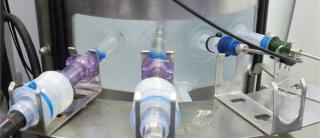
Photo 1: ()
Required General Properties
Defining key user requirements for a single-use sensor is integral to the features of commonly used bags and filters. A wide range of requirements must be considered when designing an application for single-use sensors for process monitoring. User requirements are important because of the intricacies of the components, process, and design (process and component design) as well as assembly and supply chain considerations. The “User Requirements” box lists other factors.
The last item on that list (low cost) has not traditionally been a user requirement. However, when implementing single-use technology, a significant strategy involves process economics. If process monitoring is required, sensors that are too expensive for single use may preclude its use, depending on how costs affect a cost–benefit spectrum. One way to minimize cost is to reuse noninvasive component sensing–measurement systems as much as possible — which includes expensive, highly engineered electronics.
USER REQUIREMENTS CONSIDERATIONS
Fluid Contact Material Properties
Biocompatibility and toxicology: Meet or exceed requirements for USP Class VI and/or ISO-10993-1
Prefer no risk of spongiform encephalopathies or be certified animal-derived component free (compliant with EMEA 410 Rev 2 Guidelines)
Gamma compatibility (refer to AAMI/ISO Technical Information Report 17 for relative gamma exposure stability)
Sensor Manufacturing
Monitored and controlled environment to minimize introduction of foreign matter to the sensor and components
Quality system in place that maintains lot traceability on raw materials and has documented standard operating procedures (SOPs)
Quality systems compatible with multiple customer requirements and experiences
Process Compatibility
Sensor materials compatible with solvents and solutions used in manufacturing
Sensors physically capable of withstanding process conditions with respect to time, temperature, and pressure — including process preparation and conditioning
Sensors physically integrate with a process so as not to interfere with operations and to obtain reliable process data
Performance
Meet the range of measurement accuracies and response rates required of a process
Compatible with customer calibration standards and procedures; preferably arrive calibrated and ready to use
Compatible with nonintrusive calibration and integrity testing required by customers
Control System Integration
Have either a transmitter to which the sensor can be connected or ability to integrate with off-the-shelf signal conditioning components so outputs can be read by a control system
Transmitter outputs that can be integrated to chart recorders, PLC/SCADA systems, or control system environments for recording data and/or integrated process control
Compatibility with Sterilization and/or Bioburden Reduction
Specified treatment (whether thermal, radiation, or chemical) does not affect performance or calibration of the sensor
Regulatory Approvals (if Required)
CE, RoHS of sensor and/or monitor in the EU
Low Cost
Sensor cost should not preclude its use in single-use applications
In traditional systems, sensing devices, measurement components, and a transmitter are often all one integral device. For instance, a stainless-steel pressure transducer has a sensor (typically a diaphragm), electronics (including an analog–digital converter that converts voltage change from diaphragm to pressure), and a transmitter (that converts pressure to a 4-20 mA signal for integration of other systems) all in the same housing that is attached to process piping. Separating the sensing element from the measurement system and reusing the electronics can dramatically lower the costly single-use approach in comparison with the need to dispose of the entire measurement system. This approach, however, brings about a paradigm shift in a user’s approach to calibration compared with traditional technology. Adoption Approaches
The decision to use single-use technology in a process train is generally made very early in a facility or unit operation design life cycle. Typically the determination “to go disposable” is made before a rigorous and complete evaluation of process critical parameters, PAT required for the process, and available measurement technologies. Details of integration, integrity testing, and disposal procedures of disposables are generally taken into account after the fixed capital portion of a project is significantly designed. Evaluation of sensor technology before determining user requirements is an important step in the life cycle of a design process. Just as a particular unit operation may go through many iterations and modifications in a given development life cycle, sensor technology should be continuously evaluated for its applicability and suitability for process steps.
One area of particular consideration is integrity testing and calibrating process containers and instruments used in a wett
ed disposables path. Many companies have copious experience and institutional inertia pertaining to procedures for dealing with classical reusable instruments. The biopharmaceutical industry should consider that such procedures for demonstrating suitability may need to be refined for the disposables.
For example, pressure tests of disposable, plastic components may be inappropriate for determining system integrity. Moreover, routine calibration plans and methods may be incompatible with maintaining a gamma-irritated sterile boundary. As such, the processing industry may be required to leverage statistically designed destructive and nondestructive testing methods on vendors’ manufacturing floors. Likewise, sensors may need to be precalibrated at vendors’ facilities and verifications of compliance and performance verified at the time of use.
However — given potential user quality system variations and the general state of the global supply chain — transitions are likely to lead to inconsistent and varying user requirements among end users. That would lead vendors to provide quality systems on a more ad hoc basis (customized per customer approach) rather than based on a common industry understanding and approach with more traditional technology.
User requirements impose constraints on technological approaches implemented when performing process monitoring in a wetted process path. Regarding the requirement “Preferably arrives calibrated and ready to use”: Many generic approaches are available. One approach is to manufacture a sensing element to such tight tolerances that when it is connected to any monitor it will be within product accuracy specification. Thus, potential random variations in the sensor element will vary within product specifications. Electronics in the instrument must also be solid state and not subject to variation that could contribute to accuracy shifts over time.
Another generic approach is to manufacture a sensing element and then determine individual calibration data that will allow an instrument that can accept this calibration data to read it accurately. In some way, such calibration data must be transferred to an instrument before use — either manually or (preferably) automatically. In either case, the instrument should be checked periodically to ensure there is no contribution to inaccuracy — without compromising the integrity or sterility of a system.
A third possible approach is to actually calibrate a sensor or instrument combination immediately before use. Time-of-use calibration can be performed using a cloned probe, standardized calibration solution, or off-line one-point standardizations. Introducing a standardized calibration fluid to a single-use sensing element is typically not a preferred approach because of potential carryover of the calibration solution. Manufacturing a second sensing element concomitant with the installed element that would be considered to be a clone is a viable option. The cloned sensor would be used to determine calibration information.
Finally, a routinely accepted method is to verify sensor calibration to an off-line standard. Technology Options for Primary Measurements
Single-use sensors for pressure measurement have already become widely accepted and adopted. This is partly attributed to the fact that pressure is the most critical measurement related to process performance (as well as safety) for many different bioprocesses. Products such as PendoTECH single-use pressure sensors (Photo 2) are used to measure pressure on filtration, chromatography, and disposable bioreactor processes. Photo 2:
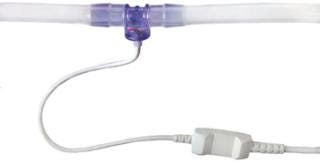
Photo 2: ()
The core technology is based on a MEMs chip (micron-sized devices formed by combining mechanical parts and electronic circuits, typically on a semiconductor chip). On these mass-produced chips, a microdiaphragm measures pressure. The chip includes temperature-compensation elements that adjust the chip’s electrical output signal based on fluid temperature. PendoTECH MEMS-HAP chips are made to very tight manufacturing tolerances, and those that pass those specifications are made into completed pressure sensors by assembly with the plastic fitting and other elements. So the critical pressure-measurement element is manufactured separate from associated expensive, precision electronic instrument components.
A PressureMAT instrument contains the precision electronics. It supplies a precise power to the MEMs chip, reads the resulting millivolt signal, and converts the signal to a pressure value. The PressureMAT instrument has a transmitter capability for integration to control systems and also built-in alarm functionality. PendoTECH pressure sensors do not require calibration when they are joined together for use in a process. However, for simulation and verification, the company’s PressureChecker tool can simulate both millivolt responses without a pressure element and provide a noninvasive pressure to the element itself through access of the pressure sensor vent port.
Temperature is most frequently measured with an RTD, thermocouple, or thermistor. Both thermistors and RTDs offer better stability and sensitivity than thermocouples. Thus, RTDs and thermistors are intrinsically better technologies for bioprocess applications. RTDs offer a wider temperature range and are more durable, although they are also much more expensive because they are frequently made of platinum. Both types of sensors work by passing a current through a device that changes resistance at various temperatures.
A thermistor is a ceramic semiconductor that can be mass-produced at low cost. Although its disadvantage compared with an RTD is that it has a narrower temperature range (with suitable sensitivity of 0–70 °C ±0.1 °C or better), a thermistor’s range suits most disposable bioprocess applications where steam-in-place and clean-in-place applications are not required. The much lower cost of thermistors also favors single-use applications. In addition, they can be manufactured to a specified accuracy and so can be used interchangeably with instruments in a facility without the need for calibration.
PendoTECH single-use temperature sensors (Photo 3) are one type of product. The thermistor is made to the specification of a 2,252-ohm at 25 °C thermistor. The thermistor can be affixed to a unit operation through a tube that is mounted to a class VI plastic in-line fitting, and it may be used with any instrument designed to read resistance. Photo 3:
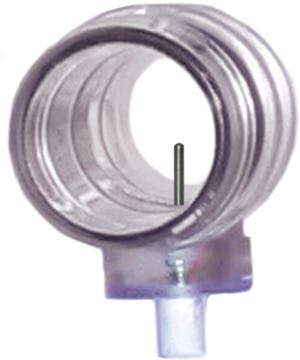
Photo 3:
Conductivity is the ability of a material to conduct electric current. The principle by which instruments measure conductivity is simple: Two plates are placed in a sample, then a potential is applied across the plates (normally a sine-wave voltage), and the current is measured.
Because the charge on ions in solution facilitates conductance of electrical current, the conductivity of a solution is proportional to its ion c
oncentration, although there also can be other ionic interactions. Because cell geometry affects conductivity values, standardized measurements are expressed in specific conductivity units (S/cm) to compensate for variations in electrode dimensions. Specific conductivity (C) is the product of measured conductivity (G) and the electrode cell constant (L/A), in which L is the length of the column of liquid between the electrode and A is the area of the electrodes: C = G×(L/A). So if the electrode cell constant is 1 cm−1, then the specific conductivity is the same as the measured conductivity of a solution.
Although electrode shape varies, an electrode can always be represented by an equivalent theoretical cell. An electrode surface is usually platinum, titanium, gold-plated nickel, or graphite. Conductivity measurements are temperature dependent. All conductivity meters have either fixed or adjustable automatic temperature compensation referenced to a standard temperature — usually 25 °C. Some have a fixed temperature compensation based on NaCl solutions at 25 °C. But a meter with adjustable temperature compensation provides an ideal match for a solution being measured.
Even though conductivity seems to be a straightforward measurement, small differences in placement of the electrodes and surface irregularities can contribute to variation among sensors. For a single-use sensor, the two ideal approaches are to manufacture an electrode to very tight tolerances so that random variation remains below the point of contributing significant inaccuracy or to determine the cell constant when an individual sensor is made. Scilog offers the latter approach for its single-use conductivity sensor, which stores on each sensor’s EPROM cell constant. When the sensor is connected to its proprietary instrument, the cell constant can be read from the EPROM and used to normalize raw conductivity measurements in mS/cm.
Flow can be measured using several different indirect methods that typically measure some property and correlate that to flow rate. Some flow-meter technologies have designs that lend themselves to potential single-use designs. Those have the best potential to meet user requirements include rotary blade (or paddle wheel), ultrasonic, or Coriolis. All three are available commercially with single-use options, but because of their different measurement principles, the best choice would be a function of accuracy requirements, cost constraints, process logistics, and material being measured.
Measuring ultraviolet (UV) light absorbance involves the commonly known Beer’s Law, which states that the optical absorbance of a chromophore in a transparent solvent varies linearly with both the sample cell pathlength and the chromophore concentration. A widely used relationship in quantitative spectroscopy, Beer’s Law is accurate enough for a range of chromophores, solvents, and concentrations.
Absorbance is measured in a spectrophotometer by passing a collimated beam of light with wavelength λ through material that is normal to the beam. Absorbance is calculated from the ratio of light energy passing through the sample to the energy that is incident on the sample. The molar absorptivity or extinction coefficient of a chromophore at wavelength λ is a property of the material as well as the solvent.
In an absorbance experiment, light is attenuated not only by the chromophore, but also by reflections from the interface between air and a sample and its container as well as absorbance by the solvent. A container in a static system is frequently a cuvette with quartz glass walls. Such factors can be quantified separately but are often removed by defining the light passing through a sample as “blank” or “baseline” or “reference sample.”
One approach to a single-use in-line UV sensor is to make a single use, in-line cuvette-like sensor with a 1-cm path length that meets the user requirements. Such strategy involves making a sensor separable from a spectrophotometer by using fiber-optic cables that can transmit light. A spectrophotometer may set the baseline with a second off-line cuvette, then the fiber optics switched to the in-line sensor. As long as air is not introduced, a spectrophotometer will measure the UV absorption as the fluid flows through the sensor.
PendoTECH introduced a single-use UV sensor that exhibits those properties. Figure 4 shows that the disposable flow cell has two compartments perpendicular to the fluid path. At the base of this compartment at the fluid path wall is quartz glass. Fiber optics from a compact UV 280 nm spectrophotometer (Photo 5) are inserted into those compartments to measure absorption. The spectrophotometer has a tare button to set the blank, and the 4–20 mA output can be integrated to a number of devices for display, data acquisition, and control. Photo 4:
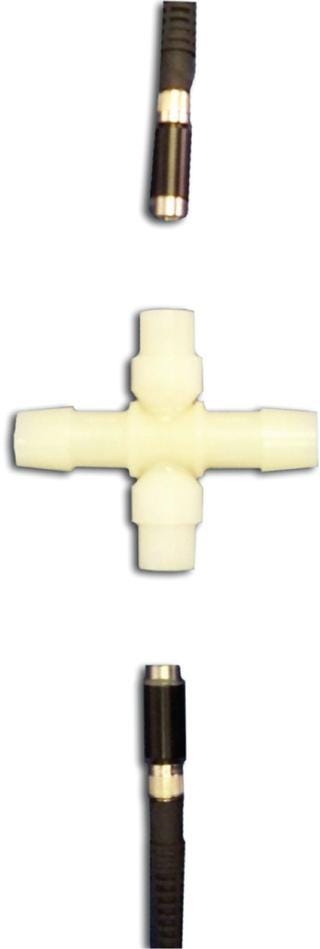
Photo 4: ()
Photo 5:
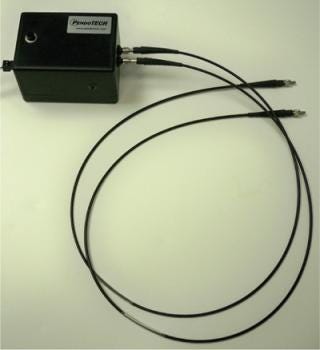
Photo 5: ()
Single-use bioreactors have become well established in the industry, and single-use sensing technologies are becoming more common in controlling critical parameters within them. Such sensors often provide advantages over traditional sensors by reducing risk of contamination caused by aseptic or sterile connections required to interface reusable sensors with a single-use system, reducing or eliminating the need for user-performed calibration and preventing product loss due to failures associated with reusing traditional sensors. Applications in which single-use sensors are most often used with single-use bioreactors include measurements of temperature, pressure, dissolved oxygen (dO2), and pH. Additional applications that are gaining acceptance include measurements of dissolved carbon dioxide (dCO2), glucose, lactate, and other key metabolites. Often, such sensors can be evaluated in parallel with traditional sensors to validate their use and performance.
Some examples of the commonly used single-use sensors include PreSens and Polestar pH and dO2 sensors. They make use of a chemistry that reacts to pH or dO2 levels in a culture fluid, causing changes in fluorescence that are detected and correlated to a pH or dO2 value. Such correlation makes use of a calibration performed by the manufacturer, which can be programmed automatically into a transmitter or control system or by an end user.
PreSens offers a microreader circuit board that has RS232, RS485, or Modbus digital communication for sensor setup and calibration and that can be integrated to control systems. Polestar also provides a transmitter that interfaces chemically for pH, dO2, and CO2 measurements and outputs 4-20mA analog signals. Finess
e Solutions developed sensors for pH and dO2 measurement using disposable sheaths assembled with the bioreactor during manufacture Each sheath contains an RTD and an RFID chip with calibration information. At time of use, an operator attaches a small electronic module to each sheath containing the emission–detection electronics and RFID reader. Those integrate with their control systems by either external or internal transmitters using an electronic cable rather than a fiber-optic cable.
As pH and dO2 adoption increases, other technologies may lend themselves to a single-use format for on-line measurements with single-use bioreactors, including Fourier-transform near-infrared (FT-NIR) spectroscopy. The single-use interface is similar to that of the UV absorbance measurements described above, typically using a flow cell on a recirculation loop or an integrated lens. FT-NIR has been used to measure glucose, lactate, ammonia, glutamine, total protein, pH, cell population density, and other analyses from a single interface. Single-use capacitance measurements have correlated well with cell population density and can be integrated with single-use bioreactors. Noninvasive fluid-level detection using sonar, radar, and other methods also have been integrated successfully in single-use bioreactor applications. A Thorough Design Is Needed
Increasing adoption of disposable sensors requires that vendors develop a thorough design life cycle. As new technologies become available, end-user requirements for measured parameters, criticality, accuracy, response time, quality, supply chain, and so forth must be considered in light of well-established methods for design, implementation, procurement, calibration, and disposal of a particular solution well before a design is finalized. Any attempt at single-use sensor implementation may trigger a reevaluation of procedures pertaining to safety, operations, and quality used throughout the design life cycle. Such reevaluations should be viewed as a part of the industry’s natural evolution and should be based on the intent of a standard and scientific applicability of a particular solution.
About the Author
Author Details
Jim Furey is general manager at PendoTECHECHECH, 66 Witherspoon Street, Ste. 256, Princeton, NJ 08542; +1-609-799-2299 ; [email protected]; Kevin Clark, PhD, is Fellow Engineer at Advent Engineering, [email protected]; and Cory Card is director of bioprocess market development at Thermo Fisher Scientific, Logan, UT 84321; [email protected]
REFERENCES
1.) Rios, M. 2010. Flexible Manufacturing: Evolving Technologies Combine to Enable a New Generation of Processes and Products. BioProcess Int. 8:34-46.
2.) Storm, E. 2010.Single-Use System Design Engineering Perspective on Selection of Commercially Available Single-Use Instrumentation IBC’s 7th International Single Use Applications for Biopharmaceutical Manufacturing, IBC Life Sciences, La Jolla.
You May Also Like






